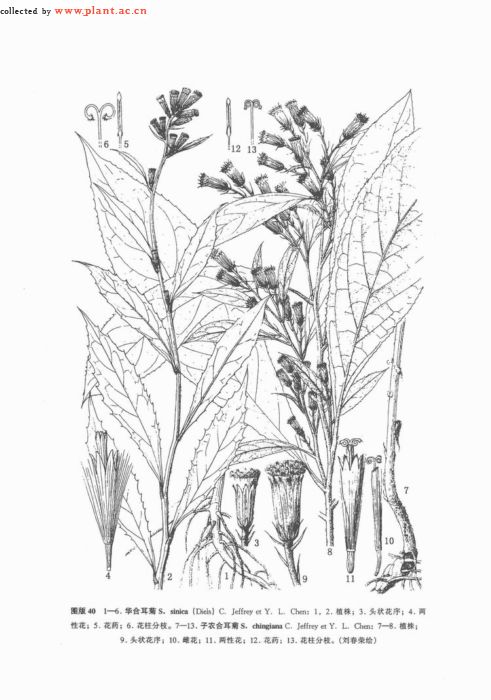华合耳菊Synotis sinica (Diels) C. Jeffrey et Y. L. Chen
华合耳菊Synotis sinica (Diels) C. Jeffrey et Y. L. Chen
19.华合耳菊 图版40: 1-6
Synotis sinica (Diels) C. Jeffrey et Y. L. Chen in Kew Bull. 39(2): 313. 1984; 贵州植物志9: 265. 1989. ——Crynura sinica Diets in Bot. Jahrb. 29: 618. 1901. ——Senecio sinicus (Diels) Chang in Bull. Fan Mem. Inst. Biol. Bot. 7: 155. 1936; Hand. -Mazz. in Acta Hort. Gothob. 12: 618. 1938; S. Y. Hu in Quart. Journ. Taiwan Mus. 21 : 144. 1968, quoad typum.
多年生草本,根状茎木质,径约6毫米,具被绒毛的纤维状根。茎单生,直立,高50-80厘米,下部无叶,上部具较密的叶,不分枝或仅花序有分枝,被黄褐色蛛丝状毛,后脱毛。叶具短叶柄,狭倒披针状椭圆形或倒披针形,长10-16厘米,宽2-3厘米,顶端渐尖,基部楔状渐狭,边缘具疏齿浅波状,齿端具小尖,纸质,上面沿脉被疏黄褐色蛛丝状毛,下面被疏短硬毛,有时紫色;羽状脉,侧脉5-7对;叶柄长0.5-1.5厘米,被密黄褐色柔毛;上部叶渐小,近无柄或无柄。头状花序无舌状花.少数,排成顶生狭圆锥状聚伞花序,或单生于上部叶腋,或在花序顶端排成腋生及顶生伞房花序;花序梗长5-10毫米,被密黄褐蛛丝状毛,具3-4线状钻形小苞片。总苞圆柱形或狭钟形,长7-9毫米,宽2-3毫米,具外层苞片;苞片3-5,短;总苞片8,线状披针形,宽1.5-2毫米,略开展,顶端渐尖且被短柔毛,草质,边缘狭干膜质,外面被疏至密蛛丝状毛。无舌状花;管状花14-15,花冠黄色,长10毫米,管部长3毫米,檐部漏斗状,裂片长圆状披针形,长1.7毫米,尖;花药长4.5毫米;花药尾部与颈部等长;附片卵状长圆形;颈部较短而宽,向基部稍膨大;花柱分枝长1.8毫米,顶端截形,被长乳头状毛。瘦果圆柱形,长3-4毫米,无毛;冠毛白色,长7-9毫米。花期7-9月。
产四川东部(南川)。贵州(普安、兴义、贞丰)。生于山坡密林中,海拔1 280-2200米。模式采自四川南川。
本种仅见于四川南川。它以头状花序盘状,无舌状花;管状花较少(14-15),冠毛白色;花药尾部与颈部等长等特征与前种显然不同。张肇骞(1936)和胡秀英(1968)所记载本种在贵州的记录(Cavaleriep)及广西的植物(S. P. Ko 56076号)头状花序辐射状,有舌状;冠毛淡黄色;花药具长为颈部2倍的尾部,应为黔合耳菊S. guizhouensis C. Jeffrey et Y. L. Chen.
形态特征:多年生草本,根状茎木质,径约6毫米,具被绒毛的纤维状根。茎单生,直立,高50--80厘米,下部无叶,上部具较密的叶,不分枝或仅花序有分枝,被黄褐色蛛丝状毛,后脱毛。叶具短叶柄,狭倒披针状椭圆形或倒披针形,长10—16厘米,宽2—3厘米,顶端渐尖,基部楔状渐狭,边缘具疏齿浅波状,齿端具小尖,纸质,上面沿脉被疏黄褐色蛛丝状毛,下面被疏短硬毛,有时紫色;羽状脉,侧脉5—7对;叶柄长0,5—1.5厘米,被密黄褐色柔毛;上部叶渐小,近无柄或无柄。头状花序无舌状花,少数,排成顶生狭圆锥状聚伞花序,或单生于上部叶腋,或在花序顶端排成腋生及顶生伞房花序;花序梗长5—10毫米,被密黄褐蛛丝状毛,具3--4线状钻形小苞片。总苞圆柱形或狭钟形,长7—9毫米,宽2—3毫米,具外层苞斤;苞片3—5,短;总苞片8,线状披针形,宽1.5--2毫米,略开展,顶端渐尖且被短柔毛,草质,边缘狭干膜质,外面被疏至密蛛丝状毛。无舌状花;管状花14—15,花冠黄色,长10毫米,管部长3毫米,檐部漏斗状,;裂片长圆状披针形,长1.7毫米,尖;花药长4.5毫米;花药尾部与颈部等长;附片卵状长圆形;颈部较短而宽,向基部稍膨大;花柱分枝长1.8毫米,顶端截形,被长乳头状毛。瘦果圆柱形,长3--4毫米,无毛;冠毛白色,长7—9毫米。花期7--9月。
产地分布:产四川东部(南川)。贵州(普安、兴义、贞丰)。生于山坡密林中,海拔1280—2200米。模式采自四川南川。
本种提示:本种仅见于四川南川。它以头状花序盘状,无舌状花;管状花较少(14—15),冠毛白色;花药尾部与颈部等长等特征与前种显然不同。张肇骞(1936)和胡秀英(1968)所记载本种在贵州的记录(Cavaleriep)及广西的植物(S.P.Ko56076号)头状花序辐射状,有舌状;冠毛淡黄色;花药具长为颈部2倍的尾部,应为黔合耳菊S.guizhouensisC.JeffreyetY.L.Chen.
参考文献:Svnotis sinica (Diels)C.JeffreyetY.L.CheninKewBull.39(2):313.1984; 贵州植物志9:265. 1989.——Oy~ura sinica Diels in Bot. Jahrb. 29:618. 1901.——Seneciosinicus(Dids)ChanginBull.FanMem.Inst.Bi01.Bot.7:155. 1936;Hand.—mcqzz. In Acta Hort. Gothob. 12:618. 1938;S. Y. Hu in Quart. Journ.TaiwanMus.21:144.1968,quoadtypum.
《Flora of China》 Vol. 20-21 (2011)
19. Synotis sinica (Diels) C. Jeffrey & Y. L. Chen, Kew Bull. 39: 313. 1984.
华合耳菊 hua he er ju Gynura sinica Diels, Bot. Jahrb. Syst. 29: 618. 1901; Senecio sinicus (Diels) C. C. Chang.
Herbs, rhizomatous. Stem solitary, erect, 50-80 cm tall, leafless in lower part, rather densely leafy above, simple or branching in synflorescence only, fulvous arachnoid, glabrescent. Leaves shortly petiolate; petiole 0.5-1.5 cm, densely fulvous pubescent; upper leaves subsessile or sessile, gradually smaller; leaf blade narrowly oblanceolate-elliptic or oblanceolate, 10-16 × 2-3 cm, papery, abaxially sparsely shortly setulose and sometimes purplish, adaxially thinly fulvous arachnoid on midvein, pinnately veined, lateral veins 10-14, base attenuate, margin rather remotely shallowly sinuate-dentate with mucronulate teeth, apex acute-acuminate. Capitula discoid, not very numerous, arranged in narrow terminal thyrses, solitary in axils of upper leaves in lower part of synflorescence, in small axillary and terminal corymbs toward apex of synflorescence; peduncles 5-10 mm, bracteate, densely fulvous arachnoid, with 3 or 4 linear-subulate bracteoles. Involucres cylindric or narrowly campanulate, 7-9 × 2-3 mm, calyculate; bracts of calyculus 3-5, short; phyllaries 8, linear-lanceolate, 1.5-2 mm wide, herbaceous, sparsely to densely arachnoid, margin narrowly scarious, apically obtusely triangular-acuminate and puberulent, somewhat spreading. Ray florets absent. Disk florets ca. 14 or 15; corolla yellow, ca. 10 mm, with ca. 3 mm tube and funnelform limb; lobes oblong-lanceolate, ca. 1.7 mm, apically acute. Anthers 4 or 5; anther tails equaling antheropodia; appendages ovate-oblong; antheropodia rather short and broad, basally slightly dilated. Style branches ca. 1.8 mm, fringed with long papillae, terminal tuft not longer than laterals. Achenes 3-4 mm, glabrous. Pappus white, 7-9 mm. Fl. Jul-Sep.● Montane forests; 1300-2200 m. Chongqing (Nanchuan), Guizhou.
别名:华尾药菊;中华尾药菊;
科名:菊科 Compositae
属名:合耳菊属 Synotis

19.华合耳菊 图版40: 1-6
Synotis sinica (Diels) C. Jeffrey et Y. L. Chen in Kew Bull. 39(2): 313. 1984; 贵州植物志9: 265. 1989. ——Crynura sinica Diets in Bot. Jahrb. 29: 618. 1901. ——Senecio sinicus (Diels) Chang in Bull. Fan Mem. Inst. Biol. Bot. 7: 155. 1936; Hand. -Mazz. in Acta Hort. Gothob. 12: 618. 1938; S. Y. Hu in Quart. Journ. Taiwan Mus. 21 : 144. 1968, quoad typum.
多年生草本,根状茎木质,径约6毫米,具被绒毛的纤维状根。茎单生,直立,高50-80厘米,下部无叶,上部具较密的叶,不分枝或仅花序有分枝,被黄褐色蛛丝状毛,后脱毛。叶具短叶柄,狭倒披针状椭圆形或倒披针形,长10-16厘米,宽2-3厘米,顶端渐尖,基部楔状渐狭,边缘具疏齿浅波状,齿端具小尖,纸质,上面沿脉被疏黄褐色蛛丝状毛,下面被疏短硬毛,有时紫色;羽状脉,侧脉5-7对;叶柄长0.5-1.5厘米,被密黄褐色柔毛;上部叶渐小,近无柄或无柄。头状花序无舌状花.少数,排成顶生狭圆锥状聚伞花序,或单生于上部叶腋,或在花序顶端排成腋生及顶生伞房花序;花序梗长5-10毫米,被密黄褐蛛丝状毛,具3-4线状钻形小苞片。总苞圆柱形或狭钟形,长7-9毫米,宽2-3毫米,具外层苞片;苞片3-5,短;总苞片8,线状披针形,宽1.5-2毫米,略开展,顶端渐尖且被短柔毛,草质,边缘狭干膜质,外面被疏至密蛛丝状毛。无舌状花;管状花14-15,花冠黄色,长10毫米,管部长3毫米,檐部漏斗状,裂片长圆状披针形,长1.7毫米,尖;花药长4.5毫米;花药尾部与颈部等长;附片卵状长圆形;颈部较短而宽,向基部稍膨大;花柱分枝长1.8毫米,顶端截形,被长乳头状毛。瘦果圆柱形,长3-4毫米,无毛;冠毛白色,长7-9毫米。花期7-9月。
产四川东部(南川)。贵州(普安、兴义、贞丰)。生于山坡密林中,海拔1 280-2200米。模式采自四川南川。
本种仅见于四川南川。它以头状花序盘状,无舌状花;管状花较少(14-15),冠毛白色;花药尾部与颈部等长等特征与前种显然不同。张肇骞(1936)和胡秀英(1968)所记载本种在贵州的记录(Cavaleriep)及广西的植物(S. P. Ko 56076号)头状花序辐射状,有舌状;冠毛淡黄色;花药具长为颈部2倍的尾部,应为黔合耳菊S. guizhouensis C. Jeffrey et Y. L. Chen.
形态特征:多年生草本,根状茎木质,径约6毫米,具被绒毛的纤维状根。茎单生,直立,高50--80厘米,下部无叶,上部具较密的叶,不分枝或仅花序有分枝,被黄褐色蛛丝状毛,后脱毛。叶具短叶柄,狭倒披针状椭圆形或倒披针形,长10—16厘米,宽2—3厘米,顶端渐尖,基部楔状渐狭,边缘具疏齿浅波状,齿端具小尖,纸质,上面沿脉被疏黄褐色蛛丝状毛,下面被疏短硬毛,有时紫色;羽状脉,侧脉5—7对;叶柄长0,5—1.5厘米,被密黄褐色柔毛;上部叶渐小,近无柄或无柄。头状花序无舌状花,少数,排成顶生狭圆锥状聚伞花序,或单生于上部叶腋,或在花序顶端排成腋生及顶生伞房花序;花序梗长5—10毫米,被密黄褐蛛丝状毛,具3--4线状钻形小苞片。总苞圆柱形或狭钟形,长7—9毫米,宽2—3毫米,具外层苞斤;苞片3—5,短;总苞片8,线状披针形,宽1.5--2毫米,略开展,顶端渐尖且被短柔毛,草质,边缘狭干膜质,外面被疏至密蛛丝状毛。无舌状花;管状花14—15,花冠黄色,长10毫米,管部长3毫米,檐部漏斗状,;裂片长圆状披针形,长1.7毫米,尖;花药长4.5毫米;花药尾部与颈部等长;附片卵状长圆形;颈部较短而宽,向基部稍膨大;花柱分枝长1.8毫米,顶端截形,被长乳头状毛。瘦果圆柱形,长3--4毫米,无毛;冠毛白色,长7—9毫米。花期7--9月。
产地分布:产四川东部(南川)。贵州(普安、兴义、贞丰)。生于山坡密林中,海拔1280—2200米。模式采自四川南川。
本种提示:本种仅见于四川南川。它以头状花序盘状,无舌状花;管状花较少(14—15),冠毛白色;花药尾部与颈部等长等特征与前种显然不同。张肇骞(1936)和胡秀英(1968)所记载本种在贵州的记录(Cavaleriep)及广西的植物(S.P.Ko56076号)头状花序辐射状,有舌状;冠毛淡黄色;花药具长为颈部2倍的尾部,应为黔合耳菊S.guizhouensisC.JeffreyetY.L.Chen.
参考文献:Svnotis sinica (Diels)C.JeffreyetY.L.CheninKewBull.39(2):313.1984; 贵州植物志9:265. 1989.——Oy~ura sinica Diels in Bot. Jahrb. 29:618. 1901.——Seneciosinicus(Dids)ChanginBull.FanMem.Inst.Bi01.Bot.7:155. 1936;Hand.—mcqzz. In Acta Hort. Gothob. 12:618. 1938;S. Y. Hu in Quart. Journ.TaiwanMus.21:144.1968,quoadtypum.
《Flora of China》 Vol. 20-21 (2011)
19. Synotis sinica (Diels) C. Jeffrey & Y. L. Chen, Kew Bull. 39: 313. 1984.
华合耳菊 hua he er ju Gynura sinica Diels, Bot. Jahrb. Syst. 29: 618. 1901; Senecio sinicus (Diels) C. C. Chang.
Herbs, rhizomatous. Stem solitary, erect, 50-80 cm tall, leafless in lower part, rather densely leafy above, simple or branching in synflorescence only, fulvous arachnoid, glabrescent. Leaves shortly petiolate; petiole 0.5-1.5 cm, densely fulvous pubescent; upper leaves subsessile or sessile, gradually smaller; leaf blade narrowly oblanceolate-elliptic or oblanceolate, 10-16 × 2-3 cm, papery, abaxially sparsely shortly setulose and sometimes purplish, adaxially thinly fulvous arachnoid on midvein, pinnately veined, lateral veins 10-14, base attenuate, margin rather remotely shallowly sinuate-dentate with mucronulate teeth, apex acute-acuminate. Capitula discoid, not very numerous, arranged in narrow terminal thyrses, solitary in axils of upper leaves in lower part of synflorescence, in small axillary and terminal corymbs toward apex of synflorescence; peduncles 5-10 mm, bracteate, densely fulvous arachnoid, with 3 or 4 linear-subulate bracteoles. Involucres cylindric or narrowly campanulate, 7-9 × 2-3 mm, calyculate; bracts of calyculus 3-5, short; phyllaries 8, linear-lanceolate, 1.5-2 mm wide, herbaceous, sparsely to densely arachnoid, margin narrowly scarious, apically obtusely triangular-acuminate and puberulent, somewhat spreading. Ray florets absent. Disk florets ca. 14 or 15; corolla yellow, ca. 10 mm, with ca. 3 mm tube and funnelform limb; lobes oblong-lanceolate, ca. 1.7 mm, apically acute. Anthers 4 or 5; anther tails equaling antheropodia; appendages ovate-oblong; antheropodia rather short and broad, basally slightly dilated. Style branches ca. 1.8 mm, fringed with long papillae, terminal tuft not longer than laterals. Achenes 3-4 mm, glabrous. Pappus white, 7-9 mm. Fl. Jul-Sep.● Montane forests; 1300-2200 m. Chongqing (Nanchuan), Guizhou.

